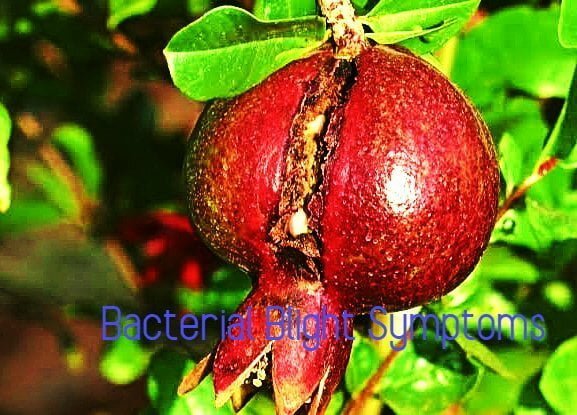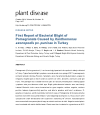

Such twigs dry out and become yellow, remaining connected to the plant until dislodged by external pressure. Blight lesions on twigs often cause girdling, resulting in the twig breaking off at the point of infection. Infections are usually found in the bark and cortex but can extend to the vascular region.

Twigs and stems show brownish-black lesions that begin at the nodes and progress along the bark. The yellowing and premature drop of leaves are common symptoms of infection. Occasionally, lesions will consolidate, and they will spread along veins and the midrib. The presence of a translucent halo, however, may be obscured in more advanced lesions. Tiny water droplets Foliage shows wet lesions that darken to black with a translucent halo around a necrotic core over time. Star-shaped black spots appear on the fruit.Branches that are more attacked to disease break off.Bacterial blight of pomegranate symptoms, black and brown spots appear on the leaves.The pathogens enter the plant’s fruit through wounds and stomata, affecting the plants.īacterial Blight Symptoms Bacterial Blight Symptoms on Fruit P omegranate disease is triggered by the fungal pathogen Xanthomonas xonopodis. Bacterial blight disease reduces the production of fruit by 30 to 50%. The bacterial blight of pomegranates is one of the most dangerous diseases of pomegranates. What is Bacterial blight? Bacterial blight of Pomegranate Pathogens can also be found and identified using molecular techniques like a polymerase chain reaction. Bacterial slime attests to the close relationship between the diseased plant portion and the blight bacterium. Pathogens (bacteria) can be identified by viewing a sample of sick tissue mounted in a drop of water on a glass slide under a microscope for signs of bacterial slime. The symptoms of blight on leaves, stems, and fruits have been previously described. The pathogens enter the plant’s fruit through wounds and stomata, affecting the plants. Pomegranate disease is triggered by the fungal pathogen Xanthomonas xonopodis. The culture and PCR based detection assay further confirmed that the bacterial blight pathogen displayed no translaminar systemic movement and caused only localized lesions.The bacterial blight of pomegranate is one of the most dangerous diseases of pomegranate. punicae infects plant tissues through both natural opening as well as by injuries. The spray method of inoculation is, therefore, recommended as a rapid, reproducible screening technique for pomegranate genotypes in resistance breeding programmes. The most favorable condition for onset of blight as well as completion of disease cycle was when temperature ranged between 25-35☌ for at least 16h and relative humidity >30% for 24h. The incubation period for blight development ranged from 4 to 19 days depending on temperature and humidity conditions. Besides, the lesions which appeared on plants mimicked the natural symptoms observed in orchards. Spray method was found to show blight symptoms on leaves with incidence of 71.0% and severity of 55.5%. punicae on pomegranate, the spray method convincingly proved that spraying of inoculum yielded highly reproducible symptoms within 21 days under optimal temperature and humidity conditions and up to 39 days under less favourable conditions. Among nine different inoculation methods evaluated for X. The pathogen caused blight symptoms on all plant parts except roots and flower. Some of the symptoms are reported for the first time. punicae on various pomegranate plant parts including fruit are described and illustrated. Complete range of symptoms of bacterial blight caused by Xanthomonas axonopodis pv.


 0 kommentar(er)
0 kommentar(er)
